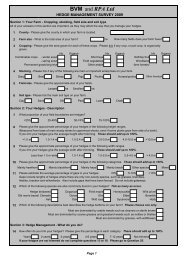How to Manage your Hedges for Hairstreak Butterflies x x - Hedgelink
How to Manage your Hedges for Hairstreak Butterflies x x - Hedgelink
How to Manage your Hedges for Hairstreak Butterflies x x - Hedgelink
Create successful ePaper yourself
Turn your PDF publications into a flip-book with our unique Google optimized e-Paper software.
<strong>How</strong> <strong>to</strong> <strong>Manage</strong> <strong>your</strong> <strong>Hedges</strong> <strong>for</strong><strong>Hairstreak</strong> <strong>Butterflies</strong>Introduction<strong>Hedges</strong> are more than just lines of shrubs. They usually have some sort ofherbaceous growth at or near the base and many contain emergent trees.They may be set on banks and can have ditches along one or both sides.The best hedges have wide margins, often referred <strong>to</strong> as buffer strips orheadlands, which are managed differently from the arable or grass crop.These five different components: mature/emergent trees, shrub layer,base/bank, ditch and margins, need <strong>to</strong> be thought about when decidinghow <strong>to</strong> manage a hedge.There are five species of hairstreak butterfly in Britain, two of which areclosely associated with hedges. These are the brown hairstreak Theclabetulae and the white-letter hairstreak Satyrium w-album. Two more, theblack hairstreak S. pruni and the purple hairstreak Neozephyrus quercusmay also occur in hedges. Green hairstreaks Callophrys rubi are less likely<strong>to</strong> be associated with hedges although several of their food plants do occurin hedges.Brown <strong>Hairstreak</strong> butterflyPho<strong>to</strong>: Rob Wol<strong>to</strong>nA Good Hedge <strong>for</strong> <strong>Hairstreak</strong> <strong>Butterflies</strong>This advice sheet concentrates on the brown and white-letter hairstreakbutterflies because they are most likely <strong>to</strong> be affected by hedgemanagement. A good hedge <strong>for</strong> hairstreak butterflies will feature maturetrees, especially ash and elm trees, which are important both as assemblypoints and as a shelter feature.Brown hairstreaks depend upon a ‘master’ tree close <strong>to</strong> the breeding site.This is usually an ash tree. They also need vigorous blackthorn bushes withsome south-facing branches and young growth. Flowers with flat openinflorescences such as hemp agrimony, ragwort and thistles in the fieldmargin will provide nectar sources.White-letter hairstreaks depend upon mature elms (including suckers thathave reached sufficient age <strong>to</strong> bear flowers). Younger flower-bearing twigson the south-facing side of the hedge are essential. The butterflies willnectar at flowering plants such as bramble and wild privet in the shrub layerand hogweed, thistles and hemp agrimony in the field margins.Mature ash tree in hedgePho<strong>to</strong>: Rob Wol<strong>to</strong>nHedge Components usedby <strong>Hairstreak</strong> <strong>Butterflies</strong>Mature/EmergentTreesShrub LayerBank/BaseDitchxxHogweed in marginPho<strong>to</strong>: Rob Wol<strong>to</strong>nMargin
Key <strong>Manage</strong>ment TipsA hedge can be improved <strong>to</strong> support hairstreak butterflies by: Encouraging young growth of blackthorn and elm in sheltered situations. This is critical <strong>to</strong> maintain colonies ascomplete removal of young growth will rapidly eliminate them. Blackthorn hedges should be trimmed on a two <strong>to</strong> three year rotation after the end of August. Cutting alternate sides ofthe hedge will also help <strong>to</strong> ensure that colonies survive. Trimming the hedge sides and <strong>to</strong>ps on alternate years may alsohelp <strong>to</strong> maintain a vigorous population. Where the brown hairstreak is known <strong>to</strong> occur at least a third of blackthorn on thesouth-facing side should be left uncut each year. South-facing hedges and those which have a sheltered warm micro-climate should be treated with particular care.Conservation field margins can be used <strong>to</strong> encourage the growth of young blackthorn in sunny field corners. If a hedge is wide enough, creating scallops along the hedge can provide areas of sheltered young growth. Allowing suitable trees <strong>to</strong> develop. In areas where elm suckers occur, letting some of these gain height and maturitywill help white-letter hairstreak. Encouraging occasional mature ash trees will help in areas where the brown hairstreakis known <strong>to</strong> occur. Encouraging flowering plants such as bramble and wild privet, close <strong>to</strong> suitable breeding sites <strong>for</strong> hairstreak butterflies.Ecology of the <strong>Hairstreak</strong> <strong>Butterflies</strong>Adult hairstreak butterflies are often overlooked because they usually fly highamongst the canopy of trees; but they will visit flowers in the shrubby part ofthe hedge or in the field margin. They also require sheltered warm places <strong>for</strong>egg laying. Brown hairstreaks require an assembly point or ‘master tree’,which is usually an ash tree with aphid honeydew that provides a food source<strong>for</strong> the butterflies. Mating occurs at higher elevations.<strong>Hairstreak</strong> butterflies share several common features in their life cycle,spending the majority of their lives as an egg, laid in the summer, hatchingin<strong>to</strong> a caterpillar the following spring. <strong>Hairstreak</strong> butterflies lay their eggs<strong>to</strong>wards the tips of twigs. Both black and brown hairstreaks requireblackthorn and normally lay their eggs in the <strong>for</strong>k between two young twigs.Their caterpillars feed on young blackthorn leaves.Elm tree in hedgePho<strong>to</strong>: Rob Wol<strong>to</strong>nThe brown hairstreak pupates beneath the bush amongst surface litter, whilstblack hairstreak caterpillars pupate attached <strong>to</strong> twigs and mimic a birddropping. The white-letter hairstreak requires elm and normally lays its eggson twigs in the area between the newest growth and the second year growth.Its caterpillars feed on the flowers of elm and then on the leaves be<strong>for</strong>epupating, attached <strong>to</strong> a leaf or twig. Purple hairstreaks favour oak; theircaterpillars initially burrow in<strong>to</strong> oak buds be<strong>for</strong>e their first moult, after whichthey feed on young leaves; mature caterpillars pupate in soil or loose litterand amongst crevices.The brown hairstreak butterfly is widely distributed in southern England andsouthern Wales, extending north <strong>to</strong> Worcestershire and Lincolnshire in wellwooded landscapes where blackthorn is a common shrub of woodland edge and hedges.White-letter hairstreak butterflies occur more widely across the countryside and extendtheir range as far as Northumberland and Cumbria.Brown <strong>Hairstreak</strong> butterfly eggPho<strong>to</strong>: Rob Wol<strong>to</strong>nThe very rare black hairstreak is confined <strong>to</strong> a few counties from Ox<strong>for</strong>dshire through <strong>to</strong> Cambridgeshire (in woods andadjacent hedges on clay soils). The purple hairstreak is the most widely distributed species and occurs throughoutEngland and Wales, north <strong>to</strong> central and south-western Scotland and Northern Ireland.The brown hairstreak and the white-letter hairstreak are both priority species listed in Section 41/42 of the NaturalEnvironment and Rural Communities Act (2006). The brown and black hairstreaks are also protected under the Wildlifeand Countryside Act, 1981 (as amended).Further in<strong>for</strong>mationButterfly Conservation — www.butterfly-conservation.orgThomas, J. & Lewing<strong>to</strong>n, R. (2010) The <strong>Butterflies</strong> of Britain & Ireland. British Wildlife Publishing Ltd.<strong>Hedgelink</strong> leaflet (2013)The Complete Hedge Good <strong>Manage</strong>ment Guide. www.hedgelink.org.uk













